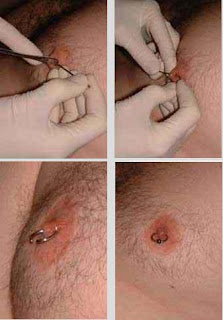
For those who choose to have their nipples pierced, healing times run between three and six months for most men, and six to twelve months for most women. This is a major piercing, considered a deep tissue wound technically. The piercing heals from the outer edges back towards the center and can often take a long time to become comfortably established. Women experience longer healing times as their piercings are often through more body tissue and their breast tissue changes with hormonal fluctuations.
Nipple Piercing Prep:
Set-up, Marking and Clamping
This series of pictures was taken on November 2, 2002 while my friend George got his nipples pierced at Body Manipulations in San Francisco. The piercer is Joey and she is an expert at what she does. The whole piercing process was over in less than half and hour and was utterly bloodless. I held George's hand with one hand and took pics with the other. He didn't squeeze my hand hardly at all, even though he thought he had.
 How Are Nipples Pierced?
How Are Nipples Pierced?Nipple piercing is a fairly straightforward and easy body modification procedure. No anesthetics are used, as their use is regulated and restricted to doctors, so it would actually be illegal for body piercers to use them. The piercing itself takes only a few seconds.
First the nipple area is cleaned and marked so that entry and exit holes for the ring are located and lined up properly. The piercings are most often set at the base of the nipple, where it joins the aureola.
Next a medical clamp called a Pennington forcep is applied to the nipple, holding the tissue firmly and lining up the two dots for the holes as closely together as possible.
Then holding a cork on one side to catch the needle, the piercer quickly does the actual piercing with a slant-tip hollow needle. Nipple piercings needs to be at least 14g in thickness to prevent tissue tearing.

The clamp is removed and the needle is almost all the way through the piercing. Then the ring is butted up against the end of the needle and is used to push the needle out, allowing the ring to slide smoothly into place.
The captured bead ring is then in place and is ready to have a bead inserted between the two end and be pinched closed.
Nipple Piercing Procedure: Piercing, Ring Insertion and Ring Closure
Well, this is about as close to a live nipple piercing as you can get in photographs.
Far Left: With the nipple marked and clamped, Joey lines up the 14ga needle. Depending on the experience level of the piercer and the thickness of the tissue, piercer sometimes push the needle into a cork to catch the sharp end.
Second from Left: Joeys slides the needle through George's nipple, and lines up the ring. Since the ring is the same thickness as the needle, when she slides it into place, there is little or no blood.
Second from Right: The 14ga captured bead ring in place, and realigned correctly. The jewelry is still open.
Far Right: The hematite bead is no set into place in the ring ends, and the jewelry is now officially closed.
Ring ready to be closed with a bead





0 comments:
Post a Comment